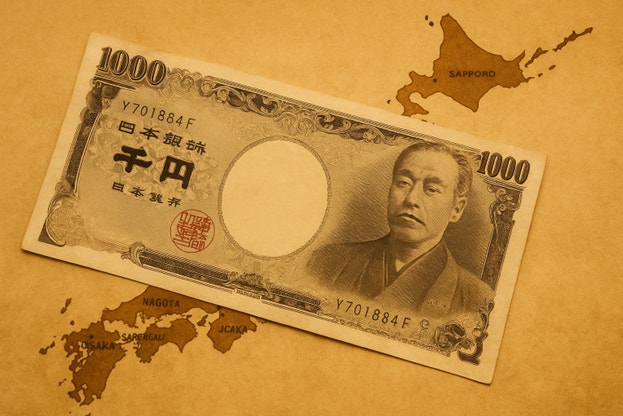Dollar Rebounds as Japan’s Election Results Shake the Yen
Japan’s new leader may have just extended the carry trade—and the dollar is loving it.

Key Points
- The U.S. dollar strengthened sharply against the yen in early October, with USD/JPY breaking toward 153 in its biggest weekly advance of the year.
- Japan’s surprising election results, and expectations of renewed Abenomics-style stimulus, catalyzed newfound dollar strength in this key currency pair.
- With the DXY Index rallying toward 99, safe-haven flows could serve as a continuing tailwind for the greenback—especially if the shutdown in Washington lingers.
For a few days in early October, the U.S. government shutdown—the main story out of Washington—took a backseat to developments in Tokyo. Traders shifted their focus from political gridlock in the U.S. to a sudden leadership shake-up in Japan that triggered a sharp currency move in the USD/JPY pair.
Japan’s election results caught markets off guard, reviving speculation about renewed stimulus and looser monetary policy. And the yen’s rapid selloff underscored how quickly global capital can pivot when policy expectations shift. Today, we break down how Tokyo’s political surprise became an unexpected catalyst for dollar strength—and what might be next for the greenback if the U.S. shutdown drags on.
Dollar Rebounds Even as Washington Shutdown Continues
At first glance, the U.S. dollar’s latest rebound seems counterintuitive. With the federal government shut down and fiscal dysfunction dominating headlines, most traders would expect the greenback to lose ground. Instead, the opposite has happened. The DXY dollar index—which tracks the U.S. currency against a basket of major peers—climbed from its 52-week low of 96.22 and now hovers around 99. This marks a sharp turnaround that few predicted heading into October.
However, as we noted back in August, there were reasons to believe in a dollar rebound. In times of global uncertainty, the U.S. dollar’s status as the world’s reserve currency often overshadows the domestic narrative. When volatility spikes—as it did on October 10—investors typically retreat to U.S. assets, drawn by the depth and liquidity of dollar-denominated markets. Paradoxically, the very turmoil that might be expected to erode confidence in the dollar often ends up reinforcing it.
That dynamic has played out in volatile fashion recently. Gold's sharp rally underscores a renewed bid for safety, as political tensions and uneven global data weigh on risk appetite. Treasury yields have eased, equities have stumbled, and traders have quietly rebuilt long-dollar exposure—though the path hasn't been entirely smooth. On October 10, the dollar sharply reversed lower on renewed tariff threats against Chinese goods, only to recover by October 13 as those concerns eased over the weekend. The overall pattern still reflects a familiar flight-to-quality dynamic that tends to emerge when uncertainty takes hold.
But the move hasn't been uniform. The euro has only edged lower against the greenback in recent sessions, while the dollar's advance against the yen has been far more pronounced. In the week leading up to October 10, the greenback surged nearly 4% versus the yen, fueled by Japan's election results and expectations that the incoming government will favor looser monetary and fiscal policies—potentially adding further downside pressure to the Japanese currency.
Japan’s Political Shift Sends the Yen Tumbling
While the government shutdown in Washington has captured most of the headlines, the more consequential story for global currency markets this month may be unfolding in Tokyo. Japan’s unexpected election outcome has brought new leadership to power, sparking a sharp move in the yen—and much of the dollar’s recent strength can be traced to this political shift.
The election (held earlier this month) delivered a surprise victory for Sanae Takaichi—a conservative lawmaker and close ally of the late Prime Minister Shinzo Abe. Her win immediately reshaped expectations for Japan’s fiscal and monetary trajectory, reviving talk of a return to “Abenomics”—a mix of aggressive government spending and dovish monetary policy designed to spur growth and weaken the yen.
The market’s response was immediate. The yen plunged roughly 4% against the dollar within days, with USD/JPY climbing to around 153—its strongest level since August. The election surprise also prompted traders to unwind expectations of near-term tightening by the Bank of Japan, betting instead that policymakers will remain on hold at least until December.
That shift has reignited one of the oldest forces in global finance—the carry trade—as investors once again borrow cheaply in yen to pursue higher yields abroad. This was evidenced by renewed optimism in Japanese equities, which surged roughly 8%, before cooling off slightly when global markets sold off on October 10. This rally was led by exporters and defense firms that appear likely to benefit from a weaker currency.
For global traders, the takeaway is clear: Japan’s political reset has widened the yield gap with the United States, fueling renewed dollar strength in the USD/JPY pair. What began as a government shutdown story in Washington has morphed into a broader narrative of monetary divergence—one in which Tokyo’s pivot, more than Washington’s paralysis, is doing the heavy lifting for the greenback.
Takeaways
The dollar’s recent rebound has been driven largely by developments abroad, but the U.S. government shutdown could soon reclaim center stage in shaping its near-term trajectory. If the impasse in Washington drags on, a prolonged shutdown could dampen growth expectations and revive safe-haven demand for U.S. assets—supporting the greenback in the short term, much as it has during past bouts of fiscal uncertainty.
Over the longer run, however, the picture becomes more complex. A resolution in Washington that includes significant new spending—amplifying already mounting deficit concerns—could ultimately weigh on the dollar. Under that scenario, traders may begin to question whether U.S. policy credibility, rather than global risk sentiment, will drive the dollar’s next major move.
Readers should also keep in mind that the dollar’s next major catalyst—the September CPI report, originally scheduled for October 15—is now slated to release on the 24th due to the ongoing shutdown. This uncertainty adds yet another wrinkle to an already fragile economic backdrop.
